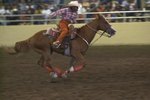
Equine corks, more commonly known as caulks or studs, are metal pegs that are screwed into a horse's shoe that act like cleats. Screw-in corks are the most common and are seen in eventing, polo, show jumping, racing, dressage and field hunters. Corks come in a variety of sizes and shapes and using the right corks can give your horse added grip over rough terrain.
Road Corks
Occasionally referred to as flat corks, road corks are designed for traveling on hard flat surfaces where a horse needs a bit of extra grip. This type of cork is usually short, flat and typically has four or six sides.
Bullet Corks
Rounder and sharper than road corks, bullet corks are helpful when the ground is slippery. Named after their bullet shape, bullet corks press through the grass or mud to obtain grip where the surface is more solid.
Grass Corks
Grass corks are long, narrow and sharp pegs that are designed to be used on hard, grassy footing or in packed, sandy arenas. Their pointed shape allows them to bite through hard ground better than road or bullet corks.
Mud or Deep Footing Corks
Mud corks are the largest of the corks. They are designed to provide deep traction on very soft or wet surfaces. Mud corks come in various shapes and are designed to dig through the top layer of mud to get to solid footing.
Using Corks
For corks to be used, a farrier must first prepare your horse's shoes by drilling and tapping 3/8 inch holes into the heels of your horse's shoes and occasionally the toes of the horseshoes. Once your horse's shoes have been tapped, screw your corks into your horse's shoes with a wrench. If you are new to using corks, consult your horse's veterinarian and your farrier before using corks. The use of corks in combination with some hoof and leg conditions is not recommended.
References
Resources
Photo Credits
-
Hemera Technologies/PhotoObjects.net/Getty Images
Writer Bio
Alie Maheux has been a freelance writer and researcher since 2007. She writes for several online firms, and specializes in business, health, travel, and equine related journalism. Maheux holds a Bachelor of Arts in business and economic science from Saint Leo University and she is perusing a Master of Science in occupational therapy and medical anthropology.



